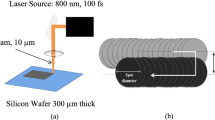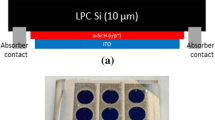Abstract
The use of a laser annealing and chemical texturing process (dubbed the LaText process) on room-temperature sputtered ZnO:Al has been shown to generate unusually high haze properties, favorable for thin film silicon solar cells.This is due to the melting of the ZnO:Al layer by the XeCl laser, and the formation of crystalline domains onthe surface, for which the grains and grain boundaries are subsequently etched at different rates. The unusual surface morphology produced through this process can strongly impact the nature of the amorphous or microcrystalline silicon material deposited thereupon. In this paper, we report on results for amorphous silicon devices, for which the surface texture is seen to slightly impact thelight absorption in the material, but more interestingly, also the light-induced degradation of the cells.For co-deposited cells, devices deposited on surfaces with the characteristic “LaText” morphologyundergo a much lesser degradation. Furthermore, the decreased degree of degradation coincides with a notable shift in the Raman scattering peak. This provides a rapid diagnostic for testing multiple textures and deposition parameters.
Similar content being viewed by others
References
T. Minami, Semicond. Sci. Technol. 20, (2005) S35.
C. Agashe, O. Kluth, J. Hupkes, U. Zastrow, and B. Rech, J. Appl. Phys. 95 (2004) 1911.
M. Berginski ; J. Hupkes ; W. Reetz ; B. Rech and M Wuttig. Thin Solid Films 516 (2008) 5836.
S. Fay, L. Feitknecht, R. Schluchter, U. Kroll, E. Vallat-Sauvain, and A. Shah, Sol. Energy Mater. Sol. Cells 90 (2006) 2960. 10.1016/j.solmat.2006.06.003
E. V. Johnson, C. Charpentier, T. Emeraud, J.F. Lerat, C. Boniface, K. Huet, and P. Prod’homme, and P. Roca iCabarrocas, Amorphous and Polycrystalline Thin-Film Silicon Science and Technology - 2011 (Mater. Res. Soc. Symp. Proc.) A13.5.
E. V. Johnson, P. Prod’homme, C. Boniface, K. Huet, T. Emeraud, and P. Roca I Cabarrocas, Sol. Energy Mater. Sol. Cells 95, (2011) 2823. 10.1016/j.solmat.2011.05.043
D. L. Staebler and C. R Wronski. Appl. Phys. Lett. 31 (1977) 292.
S. Hegedus ; W. Buchanan ; X. Liu ; R Gordon., Photovoltaic Specialists Conference, 1996., Conference Record of the Twenty Fifth IEEE (1996) 1129. 10.1109/PVSC.1996.564330
P. Tzanetakis, Sol. Energy Mater. Sol. Cells. 78, (2003) 369.
M. Boccard, P. Cuony, M. Despeisse, D. Dominé, A. Feltrin, N. Wyrsch, and C. Ballif, Sol. Energy Mater. Sol. Cells 95, 195–198 (2011).
Author information
Authors and Affiliations
Rights and permissions
About this article
Cite this article
Boukhicha, R., Johnson, E., Daineka, D. et al. Impact on Thin Film Silicon Properties and Solar Cell Parameters of Texture Generated by LaserAnnealing and Chemical Etching of ZnO:Al. MRS Online Proceedings Library 1536, 45–50 (2013). https://doi.org/10.1557/opl.2013.914
Published:
Issue Date:
DOI: https://doi.org/10.1557/opl.2013.914




